
Leonotis is a genus of flowering plants in the family Lamiaceae. One species, Leonotis nepetifolia, is native to tropical Africa and southern India. It is naturalized throughout most of the tropics. The other species are endemic to southern + eastern Africa.

Traditional medicine comprises medical aspects of traditional knowledge that developed over generations within the folk beliefs of various societies, including indigenous peoples, before the era of modern medicine. The World Health Organization (WHO) defines traditional medicine as "the sum total of the knowledge, skills, and practices based on the theories, beliefs, and experiences indigenous to different cultures, whether explicable or not, used in the maintenance of health as well as in the prevention, diagnosis, improvement or treatment of physical and mental illness". Traditional medicine is often contrasted with scientific medicine.
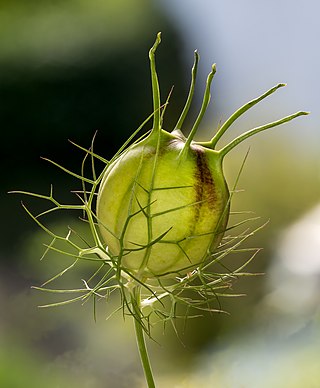
Nigella is a genus of 18 species of annual plants in the family Ranunculaceae, native to Southern Europe, North Africa, South Asia, Southwest Asia and Middle East. Common names applied to members of this genus are nigella, devil-in-a-bush or love-in-a-mist.

Brassica nigra, or black mustard, is an annual plant cultivated for its dark-brown-to-black seeds, which are commonly used as a spice. It is native to tropical regions of North Africa, temperate regions of Europe, and parts of Asia.

Leonurus cardiaca, known as motherwort, is an herbaceous perennial plant in the mint family, Lamiaceae. Other common names include throw-wort, lion's ear, and lion's tail. Lion's tail is also a common name for Leonotis leonurus, and lion's ear, a common name for Leonotis nepetifolia. Originally from Central Asia and southeastern Europe, it is now found worldwide, spread largely due to its use as a herbal remedy.

Vernonia is a genus of about 350 species of forbs and shrubs in the Daisy family Asteraceae. Some species are known as ironweed. Some species are edible and of economic value. They are known for having intense purple flowers. There have been numerous distinct subgenera and subsections named in this genus, and some botanists have divided the genus into several distinct genera. For instance, the Flora of North America recognizes only about twenty species in Vernoniasensu stricto, seventeen of which are in North America north of Mexico, with the others being found in South America.
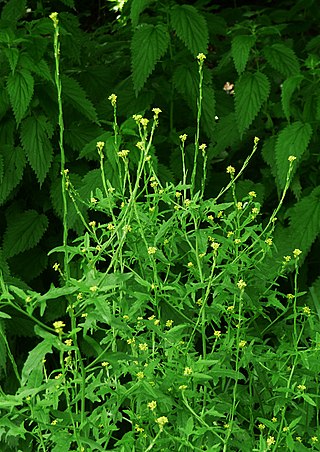
Sisymbrium officinale, the hedge mustard, is a plant in the family Brassicaceae.
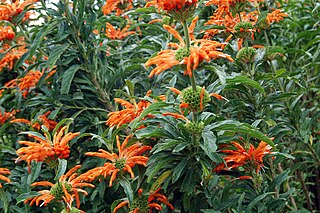
Leonotis leonurus, also known as lion's tail and wild dagga, is a plant species in the mint family, Lamiaceae. The plant is a broadleaf evergreen large shrub native to South Africa and southern Africa, where it is very common. It is known for its medicinal properties. The main psychoactive component of Leonotis leonurus is claimed to be leonurine, Leonotis leonurus has been confirmed to contain Leonurine according to peer reviewed journal published phytochemical analysis. Like other plants in the mint family, it also contains marrubiin. The word "dagga" comes from Afrikaans, and derives in turn from the Khoikhoi "dachab". The word "dagga" has been extended to include cannabis in Afrikaans and South African English, so the use of "wild" serves to distinguish Leonotis leonuris from this.

Leonotis nepetifolia,, is a species of plant in the genus Leonotis and the family Lamiaceae (mint). It is native to tropical Africa and southern India. It can also be found growing abundantly in much of Latin America, the West Indies, and the Southeastern United States. It grows to a height of 3 metres and has whorls of striking lipped flowers, that are most commonly orange, but can vary to red, white, and purple. It has drooping dark green, very soft serrated leaves that can grow up to 10 centimetres (4 in) wide. Sunbirds and ants are attracted to the flowers. It has been found growing on road sides, rubbish heaps or waste land.
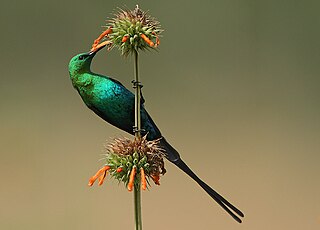
The malachite sunbird is a small nectarivorous bird found from the highlands of Ethiopia southwards to South Africa. They pollinate many flowering plants, particularly those with long corolla tubes, in the Fynbos.

Rhamnus prinoides, the shiny-leaf buckthorn, is an African shrub or small tree in the family Rhamnaceae. Commonly referred to as "gesho" it was first scientifically described by French botanist Charles Louis L'Héritier de Brutelle in 1789.

The copper sunbird is a species of passerine bird in the family Nectariniidae. It is native to tropical Africa, its range extending from Senegal and Guinea in the west to South Sudan and Kenya in the east, and southwards to Angola, Zambia, Zimbabwe and Mozambique.

The golden-winged sunbird is a species of bird in the family Nectariniidae. Three subspecies are recognised. It is found in Democratic Republic of the Congo, Kenya, Tanzania, and Uganda.
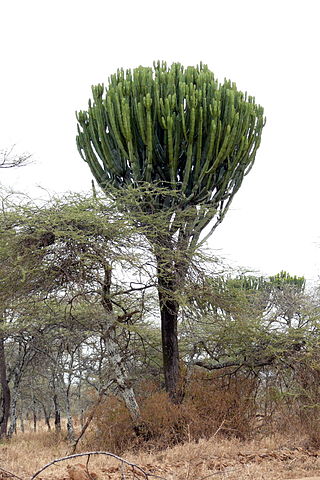
Euphorbia candelabrum is a succulent species of plant in the family Euphorbiaceae, one of several plants commonly known as candelabra tree. It is endemic to the Horn of Africa and eastern Africa along the East African Rift system. It is known in Ethiopia by its Amharic name, qwolqwal, or its Oromo name, adaamii. It is closely related to three other species of Euphorbia: Euphorbia ingens in the dry regions of southern Africa, Euphorbia conspicua from western Angola, and Euphorbia abyssinica, which is native to countries including Sudan, Eritrea, Djibouti, Ethiopia and Somalia.

AnacampserosL. is a genus comprising about a hundred species of small perennial succulent plants native to Southern Africa, Ethiopia and Latin America. The botanical name Anacampseros is an ancient one for herbs supposed to restore lost love.

Aframomum corrorima is a species of flowering plant in the ginger family, Zingiberaceae. It's a herbaceous perennial that produces leafy stems 1–2 meters tall from rhizomatous roots. The alternately-arranged leaves are dark green, 10–30 cm long and 2.5–6 cm across, elliptical to oblong in shape. Pink flowers are borne near the ground and give way to red, fleshy fruits containing shiny brown seeds, which are typically 3–5 mm in diameter.

Moringa stenopetala, commonly known as the African Moringa or cabbage tree, is a deciduous tree in the plant genus Moringa, native to Kenya and Ethiopia. A drought-resistant species, it is characterized by its bottle-shaped trunk, long twisted seed pods, and edible leaves likened to cabbage, from which its common name is derived. M. stenopetala is extirpated in the wild in Ethiopia, though still grown there as a crop on the terraces of the Ethiopian Highlands, mainly in the Konso region.

Lippia abyssinica, or koseret, is a species of flowering plant in the verbena family, Verbenaceae. It is endemic to Ethiopia but cultivated throughout tropical African countries. The specific epithet abyssinica derives from Latin and means 'of or from Ethiopia (Abyssinia)'.

Dagga is a word used in certain areas of Southern Africa to describe cannabis. The term, dating to the 1660s, derives from the word dacha in the Khoekhoe language used to describe the plant as well as various species of Leonotis. The leaves of specifically the Leonotis leonurus resemble the cannabis leaf and is known locally as wild dagga. The word has been spelled many different ways over time as various groups of people began using the term and some examples of these are: daggha, dacha, dacka, dagha, tagga, dachka, daga. According to the Oxford Dictionary, dagga was also used by the Khoekhoe to describe the sensation of intoxication.

Marantochloa purpurea is a species of plant in the family Marantaceae. It is found in tropical Africa, where its natural habitat is moist lowland forest. The leaf stems are used for various purposes including making string, baskets, mats and traps and the leaves are used for thatching, and for wrapping objects.




















